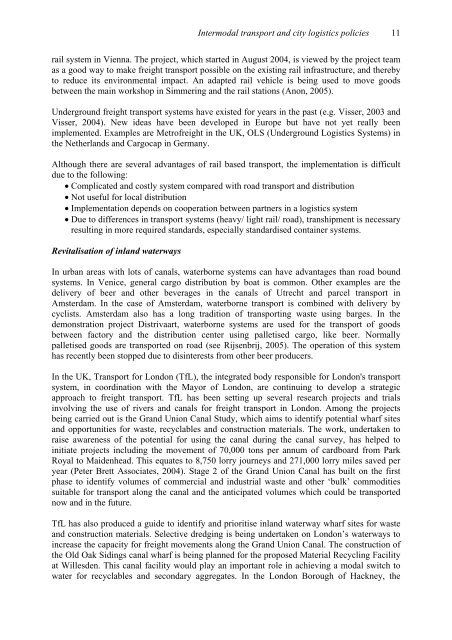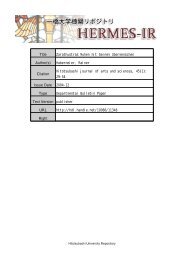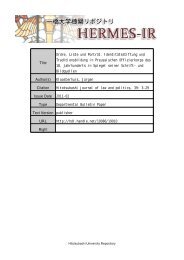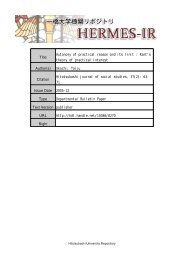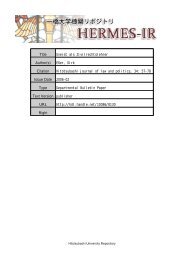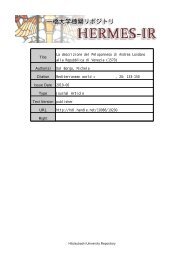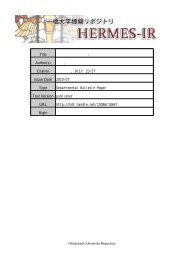intermodal transport and city logistics policies - HERMES-IR
intermodal transport and city logistics policies - HERMES-IR
intermodal transport and city logistics policies - HERMES-IR
Create successful ePaper yourself
Turn your PDF publications into a flip-book with our unique Google optimized e-Paper software.
Intermodal <strong>transport</strong> <strong>and</strong> <strong>city</strong> <strong>logistics</strong> <strong>policies</strong> 11<br />
rail system in Vienna. The project, which started in August 2004, is viewed by the project team<br />
as a good way to make freight <strong>transport</strong> possible on the existing rail infrastructure, <strong>and</strong> thereby<br />
to reduce its environmental impact. An adapted rail vehicle is being used to move goods<br />
between the main workshop in Simmering <strong>and</strong> the rail stations (Anon, 2005).<br />
Underground freight <strong>transport</strong> systems have existed for years in the past (e.g. Visser, 2003 <strong>and</strong><br />
Visser, 2004). New ideas have been developed in Europe but have not yet really been<br />
implemented. Examples are Metrofreight in the UK, OLS (Underground Logistics Systems) in<br />
the Netherl<strong>and</strong>s <strong>and</strong> Cargocap in Germany.<br />
Although there are several advantages of rail based <strong>transport</strong>, the implementation is difficult<br />
due to the following:<br />
• Complicated <strong>and</strong> costly system compared with road <strong>transport</strong> <strong>and</strong> distribution<br />
• Not useful for local distribution<br />
• Implementation depends on cooperation between partners in a <strong>logistics</strong> system<br />
• Due to differences in <strong>transport</strong> systems (heavy/ light rail/ road), transhipment is necessary<br />
resulting in more required st<strong>and</strong>ards, especially st<strong>and</strong>ardised container systems.<br />
Revitalisation of inl<strong>and</strong> waterways<br />
In urban areas with lots of canals, waterborne systems can have advantages than road bound<br />
systems. In Venice, general cargo distribution by boat is common. Other examples are the<br />
delivery of beer <strong>and</strong> other beverages in the canals of Utrecht <strong>and</strong> parcel <strong>transport</strong> in<br />
Amsterdam. In the case of Amsterdam, waterborne <strong>transport</strong> is combined with delivery by<br />
cyclists. Amsterdam also has a long tradition of <strong>transport</strong>ing waste using barges. In the<br />
demonstration project Distrivaart, waterborne systems are used for the <strong>transport</strong> of goods<br />
between factory <strong>and</strong> the distribution center using palletised cargo, like beer. Normally<br />
palletised goods are <strong>transport</strong>ed on road (see Rijsenbrij, 2005). The operation of this system<br />
has recently been stopped due to disinterests from other beer producers.<br />
In the UK, Transport for London (TfL), the integrated body responsible for London's <strong>transport</strong><br />
system, in coordination with the Mayor of London, are continuing to develop a strategic<br />
approach to freight <strong>transport</strong>. TfL has been setting up several research projects <strong>and</strong> trials<br />
involving the use of rivers <strong>and</strong> canals for freight <strong>transport</strong> in London. Among the projects<br />
being carried out is the Gr<strong>and</strong> Union Canal Study, which aims to identify potential wharf sites<br />
<strong>and</strong> opportunities for waste, recyclables <strong>and</strong> construction materials. The work, undertaken to<br />
raise awareness of the potential for using the canal during the canal survey, has helped to<br />
initiate projects including the movement of 70,000 tons per annum of cardboard from Park<br />
Royal to Maidenhead. This equates to 8,750 lorry journeys <strong>and</strong> 271,000 lorry miles saved per<br />
year (Peter Brett Associates, 2004). Stage 2 of the Gr<strong>and</strong> Union Canal has built on the first<br />
phase to identify volumes of commercial <strong>and</strong> industrial waste <strong>and</strong> other ‘bulk’ commodities<br />
suitable for <strong>transport</strong> along the canal <strong>and</strong> the anticipated volumes which could be <strong>transport</strong>ed<br />
now <strong>and</strong> in the future.<br />
TfL has also produced a guide to identify <strong>and</strong> prioritise inl<strong>and</strong> waterway wharf sites for waste<br />
<strong>and</strong> construction materials. Selective dredging is being undertaken on London’s waterways to<br />
increase the capa<strong>city</strong> for freight movements along the Gr<strong>and</strong> Union Canal. The construction of<br />
the Old Oak Sidings canal wharf is being planned for the proposed Material Recycling Facility<br />
at Willesden. This canal facility would play an important role in achieving a modal switch to<br />
water for recyclables <strong>and</strong> secondary aggregates. In the London Borough of Hackney, the


